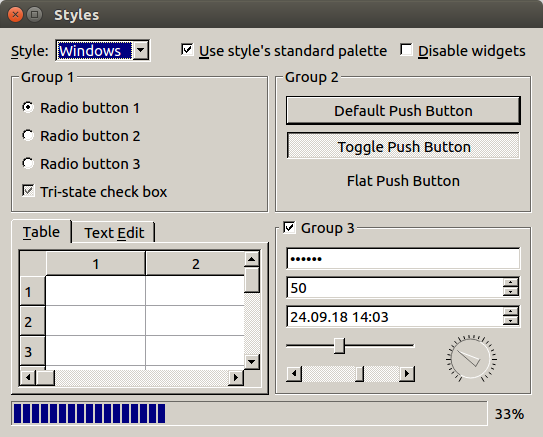

- Python pyqt5 how to#
- Python pyqt5 mac os x#
- Python pyqt5 full#
- Python pyqt5 android#
- Python pyqt5 code#
Python pyqt5 how to#
Michael Herrmann's PyQt5 book quickly shows how to create desktop applications.
Python pyqt5 android#
PyQt5 also runs on Android and iOS.Ĭurrent documentation is available for PyQt4 and PyQt5.Ī collection of links to books can be found on the Books page.
Python pyqt5 mac os x#
PyQt4 runs on Windows, Linux, Mac OS X and various UNIX platforms. PyQt contains over 620 classes that cover graphical user interfaces, XML handling, network communication, SQL databases, Web browsing and other technologies available in Qt. Both editions can be built for Python 2 and 3. PyQt is available in two editions: PyQt4 which will build against Qt 4.x and 5.x and PyQt5 which will only build against 5.x. PyQt is distributed under a choice of licences: GPL version 3 or a commercial license. PyQt provides bindings for Qt 4 and Qt 5. Qt itself is developed as part of the Qt Project. PyQt was developed by Riverbank Computing Limited. P.setColor(self.backgroundRole(), Qt.PyQt is one of the most popular Python bindings for the Qt cross-platform C++ framework. The example below paints pixels in the QPainter widget:įrom PyQt5.QtGui import QPainter, QColor, QPen Pixels are added using the drawPoint(x, y) method. P.setColor(self.backgroundRole(), Qt.white) This also contains other classes like QPen and QColor. To use the widget in Qt5 we import PyQt5.QtGui. In this article we’ll explain how to use the QPainter widget with Python. This widget supports adding pixels (dots) inside of the widget, unlike the other widgets. You can paint in a PyQt5 window using the QPainter widget. In the initUI method we add it to the window: We set the title-box to contain the horizontal layout: We create widgets (in this example QPushButtons) and add them to the layout one by one: Inside the method we create a box with a title and a horizontal layout: We start by calling the method self.createHorizontalLayout() inside the initUI() method. Self.horizontalGroupBox = QGroupBox( "What is your favorite color?")ī(self.on_click)īuttonGreen = QPushButton( 'Green', on_click( self): WindowLayout.addWidget(self.horizontalGroupBox)
Python pyqt5 code#
We will show the whole code and then explain.įrom PyQt5.QtWidgets import QApplication, QWidget, QPushButton, QHBoxLayout, QGroupBox, QDialog, QVBoxLayout In this article we’ll show you how to add buttons in the horizontal direction using a horizontal layout.

A horizontal layout can be used to (dynamically) add widgets in horizontal direction. Widgets are frequently added to a layout. We then add these tabs to the tab widget:ĭon’t forget the to add your custom tab widget to the window:Ī window can contain widgets (buttons, text field, image and others). We initialize the tab screen by creating a QTabWidget and two QWidgets for tabs. To add a table to a window, we create a new class: Print(currentQTableWidgetItem.row(), lumn(), currentQTableWidgetItem.text()) (self.pushButton1)įor currentQTableWidgetItem in ():


Self.pushButton1 = QPushButton( "PyQt5 button") The QTabWidget can contain tabs (QWidgets), which have widgets on them such as labels, buttons, images etcetera.įrom PyQt5.QtWidgets import QMainWindow, QApplication, QPushButton, QWidget, QAction, QTabWidget,QVBoxLayout PyQt5 has a widget to create tabs known as QTabWidget.
Python pyqt5 full#
We’ll show the full code first, then explain. In this article you will learn to use tabs with PyQt5. Self.title = 'PyQt absolute positioning - ' They are added to a PyQT5 window (QMainWindow) which has some properties set in initUI().įrom PyQt5.QtWidgets import QApplication, QWidget, QMainWindow, QLabel The example below puts widgets on the absolute positions using the move() method. Widgets can be added on an absolute position using the move(x,y) method. The layout you should pick depends on your preference and type of application.Ībsolute positioning gives you total control over the widget positions but you have to explicitly define every widget location. PyQt5 supports several layout methods such as grid layouts, horzontal layous and absolute positioning. If you are new to programming Python PyQt, I highly recommend this book. Window properties are set in the initUI() method which is called in the constructor. The example creates a window (QMainWindow). tGeometry(self.left, self.top, self.width, self.height) Self.title = 'PyQt5 status bar example - ' The program below adds a statusbar to a PyQt5 window:įrom PyQt5.QtWidgets import QApplication, QWidget, QMainWindow It is one of the methods the class itself contains Self.statusBar().showMessage( 'Message in statusbar.')Ī statusbar can be added to the main window (QMainWindow). This is a small bar at the bottom of a window that sometimes appears, it can contain text messages.


 0 kommentar(er)
0 kommentar(er)
